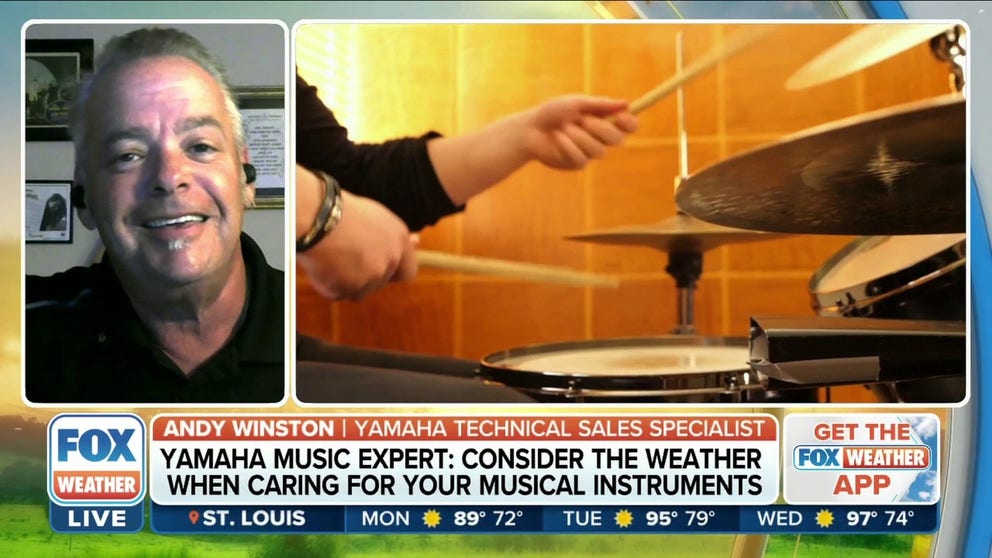How weather can change the shape and sound of musical instruments
Experts at Yamaha Corporation of America talk about how the weather can impact drums, guitars, pianos, winds and strings
How humidity and temperature can affect the sound of musical instruments
Andy Winston, Yamaha Technical Sales Specialist, suggests that people consider the weather when caring for their musical instruments.
Summer is the time for outdoor concerts. But how do the summer heat and humidity impact the instruments providing such delightful tunes?
FOX Weather talked to experts — who are themselves musicians — about the impact/role weather can make/play on drums, guitars, pianos, winds and strings.
Drums
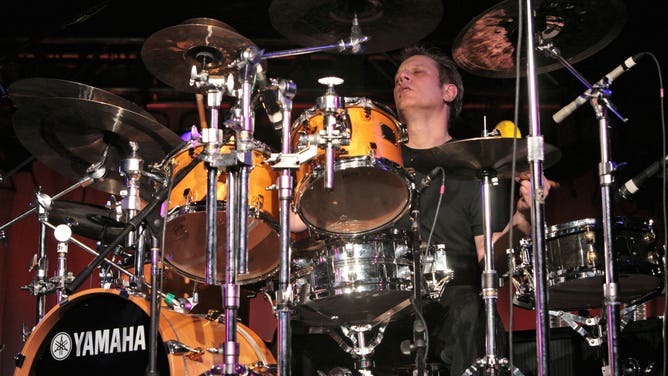
Dave Weckl performs live.
(Andrew Lepley / Redferns / Getty Images)
"Drums are the root, the core of a lot of the music we listen to," said Daryl Anderson, drum designer/artist support for Yamaha Corporation of America.
Drum shells are typically made of wood such as maple, birch and Mahogany. On the other hand, snare drums, the primary drum heard in a lot of music, can also be made of metal.
The circular surface that stretches across a drum shell, called the drumhead or skin, is often made of plastics. (As the name suggests, skins were originally made of natural materials, such as goatskin and cowhide).
Weather can take a significant toll on the different materials in drums — along with the drums’ sound quality.

A street musician plays drums in the sun and heat.
(Louisa Gouliamaki / AFP / Getty Images)
Take moisture, for example.
"In the case of the drumhead, if you were dealing with an actual natural skin playing surface, that drumhead is going to absorb the moisture and slacken and become very dead and low in pitch," Anderson said.
"That's also true of the shell itself, where the drum shell is made of wood, it's going to absorb moisture and that moisture is just going to be unnecessary mass and density for the vibrating walls."
Extreme temperatures may also damage drums.
According to Anderson, drums left in 110 degree-environments can cause paint on the drums to crack. Drum shells, which are generally made out of thin veneers and multiple plies of wood, may see those plies become unglued and separated in such high temperatures.
Sudden temperature changes may also wreak havoc on the instruments.

Roy Haynes plays drums as he leads his Fountain of Youth Band on his 90th birthday concert at the Blue Note nightclub, New York.
(Jack Vartoogian / Getty Images)
"I've seen that for drums, but also even cymbals," Anderson said. "I've seen cymbals be super, super cold, go into a warm nightclub and get struck and then just crack because they become very brittle."
To prevent this kind of weather-related damage, Anderson recommends taking notice of environmental conditions. For example, a drummer living in Florida would have to deal with factors such as salt water or high humidity, so they’d need to be sensitive to how their instrument behaves within that particular set of conditions.
He stressed the importance of having a heightened awareness of how an instrument feels and sounds, so the instrument can be cleaned and maintained before any significant damage could occur.
"If you're serious about your music, you'll want to take care of your instrument," Anderson said.
"So, if you have a job to do and you need to play that show and it happens to be a thunder shower or if you're playing a gig and it's in the middle of the desert in Las Vegas, just be aware and take notice of that and take care of your instruments accordingly."
Guitars

Yoshihiko Tanbara inspects guitars hanging on display.
(Rick Diamond / Getty Images)
"The people that don't live in the musical instrument world are certainly not aware of just how fragile acoustic guitar is," said Andy Winston, technical sales specialist of guitars, basses and amplifiers for Yamaha Corporation of America.
"It really is a finely tuned piece of art that just happens to be made of wood and happens to make beautiful sound — so, we do have to take care of it. We do have to treat it as if our living depended on it, as if we couldn't make our music without it."
Acoustic guitars are generally made of wood. Some guitars may have a spruce wood top and mahogany back, whereas others might be made entirely out of spruce or even laminate woods.
Electric guitars may use alder or mahogany for the body, with the guitar neck being made of mahogany. Electric hardware is then screwed into certain parts of the guitar.
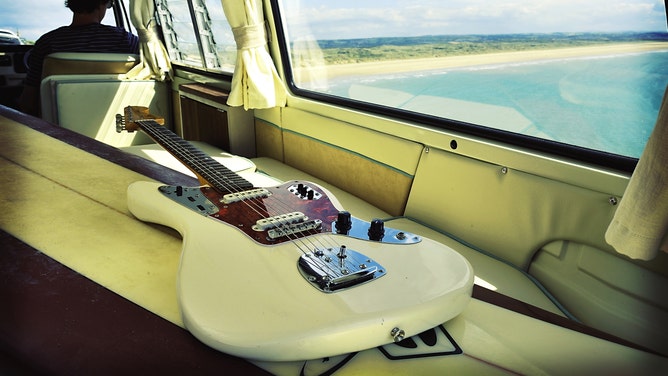
An electric guitar sits in a car, with a beach in the background.
(Joby Sessions / Guitarist Magazine / Future / Getty Images)
Temperature and moisture can wreak havoc on guitars, according to Winston.
For example, musicians who live in the South, where high humidity is the norm, may have their acoustic guitars in danger of absorbing too much moisture and having the wood of their guitars swell.
The metal components of a guitar can also be compromised by these weather conditions.
"A couple of times I had a customer come in who lived on a boat and he wondered why all of the hardware on his guitar was starting to rust and turn green," Winston said. The moist environment of his home had collected on his guitar, causing the damage.
The lack of moisture, however, can also damage a guitar. Winston noted how a guitar in dry conditions will have a tendency to crack or split, particularly where there’s the greatest pressure and tension from the strings.

Boston University students play their guitars under the sun.
(Angela Rowlings / MediaNews Group / Boston Herald / Getty Images)
However, the ideal conditions for a guitar are easily within reach.
"If you're storing guitars or have a guitar collection, try to keep that room between about 45 and 55% relative humidity," Winston said. "Yeah, it might sound like it's Florida, but it's the best thing for your instrument."
For musicians storing their guitar in a case, Winston advised tracking its humidity by using a device that sits in the guitar’s sound hole and provides readouts on humidity levels.
He also recommends keeping guitars out of direct sunlight when possible and cleaning the instrument after playing, especially in environments of high heat and humidity.
Pianos
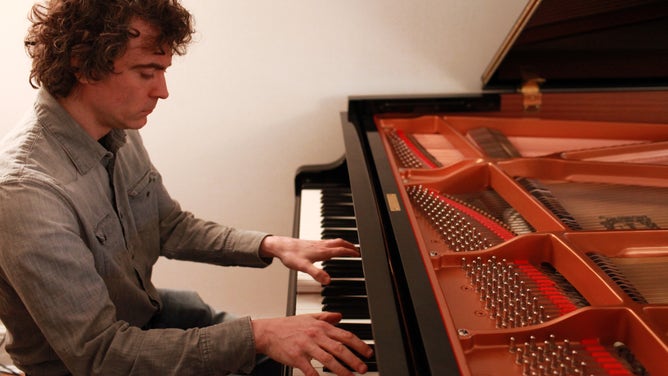
Paul Lewis plays his piano during a portrait session.
(Amy T. Zielinski / Redferns / Getty Images)
"Music is good for your soul and good for your health," said Ryan Ellison, piano services supervisor at Yamaha Corporation of America. "It's something that we hope more people have in their lives, musical instruments."
Pianos are primarily made of wood, but there are large components that are made of cast iron, steel, aluminum, copper and other metals. Felt products are used throughout the piano, plastic is used as the key top material and polyester gives pianos a shiny black finish.
The materials used in pianos, along with the piano’s maintenance needs, are most significantly affected by the humidity, according to Ellison.
"They have an ability to, you know, take in moisture and also exhaust moisture within their cellular structure," Ellison said.

Pianist Ana Vega Toscano performs 'Madrid's Romantic Composers' at the piano.
(Alejandro Martinez Velez / Europa Press )
"For example, very dry, cold temperatures, very dry, low humidity, but also high temperatures with high humidity — these extremities, situations are challenging for the piano."
Ellison noted how low humidity can cause wood in the piano to separate, as the wood is losing so much moisture that it is unable to stay together as it was built. On the flipside, high humidity can lead the wood to absorb the moisture. This causes the cell structures in the wood to elongate and then the wood will push out against itself.
"The way that affects the piano is that it stretches the strings that are on the bridge that connects to the soundboard," Ellison said. The strings are set to precise levels of tension, so when the wooden soundboard they are attached to stretch or contract, that changes the tension of the strings and causes the piano to go out of tune.
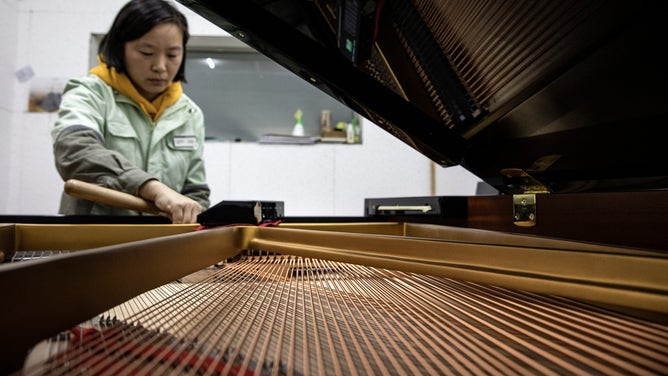
A woman tunes a piano.
(Getty Images)
For example, according to Ellison, pianos in southern California tend to experience a lot of variance in their tuning around late August/September because that is when the Santa Ana winds blow in.
"It really drops the humidity level dramatically," he said. "That wind comes down through the valley, and pianos just drop in pitch."
According to Ellison the ideal level of humidity for pianos is 45%, with an acceptable range being 35 to 55%.
"Piano is mostly just the need for maintenance throughout the cycles of the season and what you might run into in the very high humidity seasons versus the very dry seasons and what to do to prevent it or maintain it," he said.
Winds and strings

Trumpet player Branden Lewis performs.
(Chris Williams / Icon Sportswire / Getty Images)
"Everyone's a fan of music, but it's a very different thing to be part of creating music and the physicality of an instrument," said Austin Snowden, Winds & Strings product specialist at Yahama Corporation of America.
Wind instruments are grouped into different types of wood and metals. Wood instruments are most commonly made of a wood called Grenadier, an African wood that had ideal sound properties due to its hardness and density. Metal wind instruments are often made of brass, with some coated with gold or silver.
String instruments are traditionally primarily wood, such as spruce and maple, whereas some of the instruments are electric and have metal components.
No matter their components, any wind or stringed instrument can be affected by the weather.

Toronto Symphony Orchestra Sergei Nikonov, Violin and his son Anton on the clarinet play in their favourite spot, the Toronto Windsurfing Club on Cherry Beach in Toronto.
(Steve Russell / Toronto Star / Getty Images)
"If you think about it, when heat is applied to any object instrument or any anything, heat makes things expand and cold temperatures make things contract," Snowden said. "So when you're talking about an instrument that's supposed to vibrate and produce sound waves that are expanding and contracting can not only affect how those sounds resonate in the instrument but also the instrument's ability to resonate."
The physical integrity of the instrument can also be compromised.
Wooden wind and string instruments are particularly vulnerable to heat and humidity.
"You can imagine if you've got a wooden instrument, particularly where you're blowing warm air through it and that our air has moisture in it, but that in a freezing cold environment, that moisture can freeze up," Snowden said. "It can get inside the cracks of the wood and then expand even more. That can cause cracks and really harm the instrument long term."

Harriet Krijgh (l), cellist, and Jan Vogler, cellist and artistic director of the Dresden Music Festival, play a cello during a flash mob on Augustusstrasse in Germany.
(Sebastian Kahnert / picture alliance)
The changes caused by heat and humidity can also cause metal strings in instruments such as violins to warp and become damaged.
Metal wind instruments, while unable to absorb moisture, can still be affected by it. Moisture can cause the instruments to expand and contract at a molecular level, acoustically changing how the sound is projected and how the player feels that instrument is responding, according to Snowden.
"It's really important for players to be conscious of what weather environment they are in and what they are coming to or going to and coming from," Snowden said. "When you hear an instrument, a musician warming up, not only are they warming up their chops, their base, their muscles, but they also have to physically warm up their instrument."
Snowden recommends players maintain this awareness of the climate wherever they play.
"Any climate that is mostly consistent would be ideal," he said. "But no matter where you live, there's going to be some weather factors that you should be aware of and prepare for."
